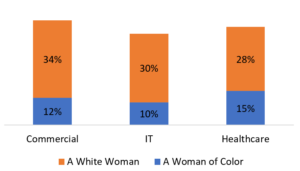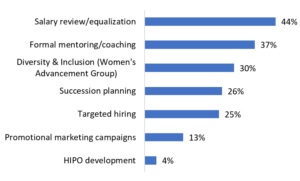Even as staffing companies navigate high churn, inflation and a tight labor market — all of which are driving up costs — they are also grappling with gender imbalances within their C-suites and on boards. To achieve balance requires DE&I strategies to support both current and future generations of women in leadership. The good news? Such initiatives can boost sales and profits and make for a stronger workplace overall.
Imbalance in the Workforce
Women’s engagement in the labor market was already much lower than men’s when the pandemic hit. Four years after lockdowns began, the ecosystem is still feeling those effects. Women’s labor force participation was 47.3% in 2022, down from 47.7% in 2019 — with a further decline projected in 2024, according to SIA’s Diversity, Equity & Inclusion Trends 2023 report, published earlier this year.
And women in the labor force experience gaps in other areas. Take weekly hours worked, for example. Prior to the pandemic, women aged 15 to 64 worked an average of 19.8 hours per week, compared to 34.7 hours for men, according to the International Labour Organization. The pandemic widened that gap, with women working 18.9 hours per week in the first quarter of 2022 compared with 33.4 for men. Why such a gap? In part, it’s because women were bearing the greater share of childcare responsibilities, resulting in limited work hours or job changes. Also, a higher percentage of women work in service industries, which were acutely affected by the pandemic.
And then there’s the leadership gap, with women far underrepresented at the upper levels and in boards across industries, including the staffing industry.
Staffing Industry Variation
 According to SIA’s 2022 Insights on Gender Parity report, women accounted for a median 66% of internal workers at US staffing firms. Despite the high proportion of women working in frontline and managerial roles, women remain underrepresented at the executive and board levels. At the median, women account for only 50% of executive positions and 37% of board seats. And those numbers decline for larger companies: While women comprise 53% of executives at small staffing firms (those with less than $25 million in revenue), this figure drops to 45% at midsize firms and 18% at larger firms. Women of color fare even worse. Of the three segments surveyed for the report, healthcare staffing firms had the highest share of women of color at the helm, 15%, followed by commercial at 12% and IT at 10%, as depicted by the accompanying graph.
According to SIA’s 2022 Insights on Gender Parity report, women accounted for a median 66% of internal workers at US staffing firms. Despite the high proportion of women working in frontline and managerial roles, women remain underrepresented at the executive and board levels. At the median, women account for only 50% of executive positions and 37% of board seats. And those numbers decline for larger companies: While women comprise 53% of executives at small staffing firms (those with less than $25 million in revenue), this figure drops to 45% at midsize firms and 18% at larger firms. Women of color fare even worse. Of the three segments surveyed for the report, healthcare staffing firms had the highest share of women of color at the helm, 15%, followed by commercial at 12% and IT at 10%, as depicted by the accompanying graph.
But what are staffing firms doing to change the landscape?
As part of the Women in Business Collaborative Benchmark Survey in 2022, SIA asked staffing firms about their strategies for supporting and advancing women within their companies. The companies cited salary review/equalization as the most common strategies. The second- and third-most common initiatives were formal mentoring/coaching and women’s advancement groups.
The Benefits of Female Leaders Across Industries
When more women are empowered to lead, everyone benefits. Decades of studies show female leaders help increase productivity, enhance collaboration, inspire organizational dedication and improve fairness, according to the American Psychological Association. Additionally, Fortune 500 companies with the highest representation of women on boards financially outperform companies with the lowest representation of women on boards, according to the Center for Creative Leadership (CCL).
Gender-diverse teams also have higher sales and profits compared to male-dominated teams and have higher average revenue than less diverse business units. The CCL study found that women in leadership not only benefited companies from a financial perspective but has been proven to have a positive impact on workplace environments. A higher percentage of women in the workplace has been shown to result in increased job satisfaction, more meaningful work and less employee burnout.
Supporting the Next Gen
In its goal to accelerate gender equality, the World Bank highlighted several objectives in its 2024-2030 Gender Strategy report. One top objective is addressing gender constraints in how women access childcare or digital platforms that can expand their economic choices and enable economic participation. Other efforts can include those that counteract stereotypes and biases in how women access earnings transparency across sectors, support in acquiring digital skills and understanding artificial intelligence technologies and certifications. Some staffing firms have developed programs that focus on diversity, equity and inclusion, and others are looking to establish policies and practices to recruit and promote women leaders to increase the female labor force. Staffing firms are primed to innovate and expand partnerships with companies such as the International Finance Corporation (IFC) that invest in technologies, expand access to finances for women and provide business skills that support women in the workplace, statistically proven to lead to productivity and output gains.
Shifting Mindset
Although gains have been made in gender equality over the past 20 years, progress is slow and requires global efforts. The uneven playing field between men and women negatively impacts productivity and decelerates growth. Behaviors, laws, and policies must change. Expediting the agenda will require effort from government, organizations and staffing firms, resulting in broader engagement, increased accountability and accelerated progress toward gender equality.








